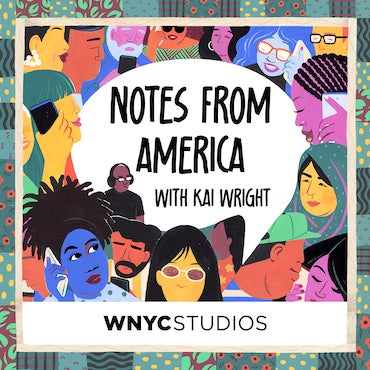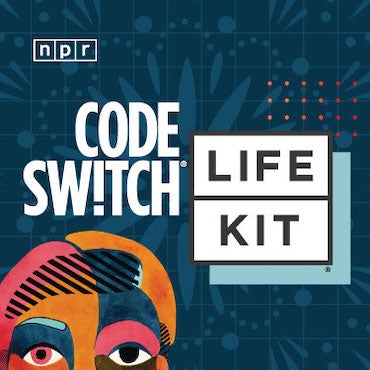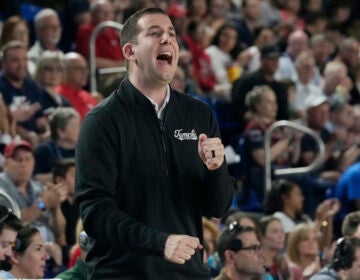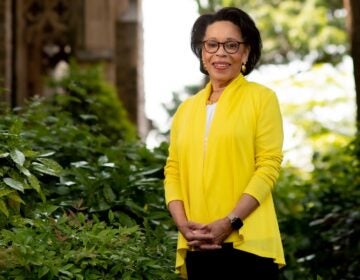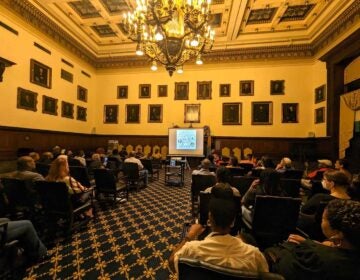Opposition to Temple stadium burns brightly one year on
“It is revolting to me that Temple would rather use their money to gentrify a historically black area than to lift them up,” proclaimed a Temple student.
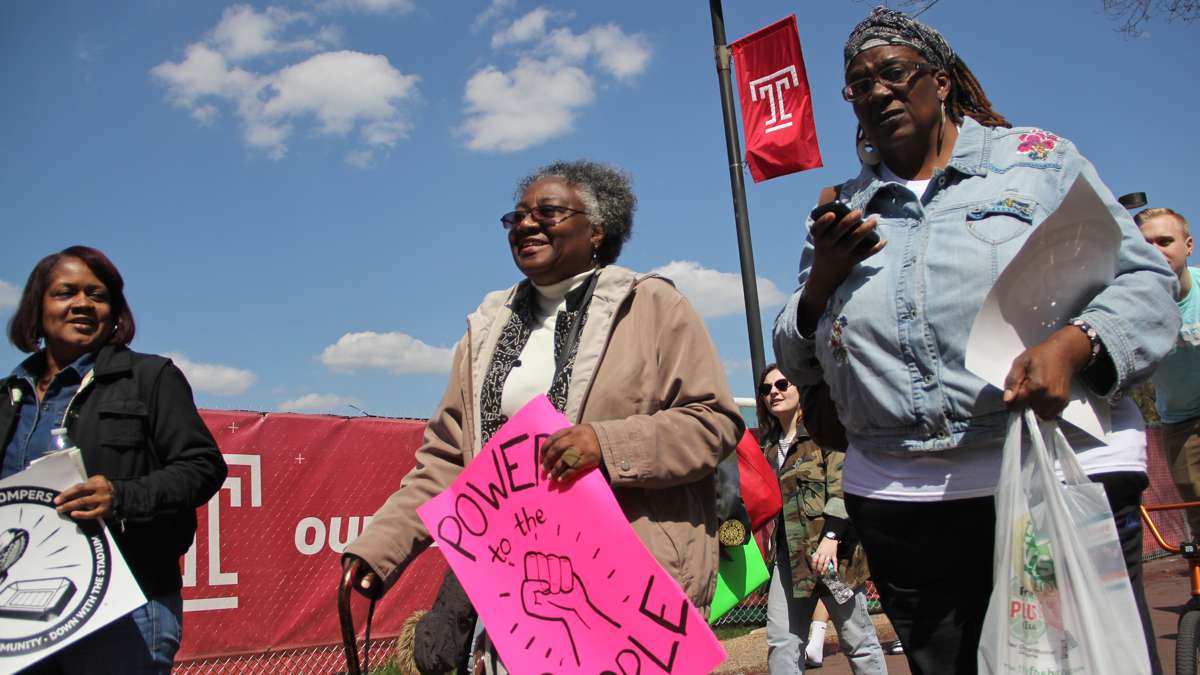
Jacqueline Wiggins (center), a long time resident of the Temple University area, joins her neighbors and students in an April 2016 protest march against a proposed new football stadium. (Emma Lee/WHYY)
On Thursday, May 25, a familiar combination of North Philadelphia community members, local activists, and Temple University students assembled at the historic Church of the Advocate on Diamond Street.
They began the meeting as they have since last May, by standing in a chorus of “Lift Every Voice and Sing.” Then they welcomed young and old, black and white, students and clergy to address the crowd in celebration of the one-year anniversary of their campaign to stop Temple’s construction of a new football stadium in North Philly. The coalition of those against the construction of the stadium has called itself Stadium Stompers.
The University announced its plans for the new stadium early last year. The proposed project would cost $126 million and seat 40,000 people. Construction is planned in a residential area, between Broad and 16th streets, Norris Street and Polett Walk.
Stadium Stompers’ primary arguments against the project are the displacement it would cause for long-term residents, the resulting increase in student tuition, and the noise, light pollution, and trash it would generate. Citizens are concerned about the economic impact, which they have described as an example of urban gentrification.
Organizer Alexandria Dotson explains, “[We are worried about] the potential increase in rent and property values for residents near the building site, which is already a problem for many people in the city of Philadelphia because of the unprecedented economic inequality from the last 20 or so years — disproportionately impacting people of color.”
“It is revolting to me that Temple would rather use their money to gentrify a historically black area than to lift them up,” proclaimed a Temple student at Thursday’s town hall meeting. “Temple University, you are a disgrace. How dare you move into this area [to build] a football stadium before the elementary schools have libraries?”
This resistance has already had an effect. In December, Temple announced that it would “play all house games at its current location of Lincoln Financial Field until at least 2018, while the University continues its feasibility study into an on-campus football stadium.”
The group marked this development as a preliminary victory, but it has since continued its push to dissuade the University from proceeding with the stadium as well as stressing the larger social issues they feel this plan underscores.
According to Dotson, “gentrification, economic inequality, and financial injustice continue to be a problem in urban areas, and Temple’s recent proposal is a symptom of a large, structural problem.”
While these issues remain in the forward vision and ideological groundwork of the group, members state that no concrete decisions have yet been made to put forth further demands. Meanwhile, they have held steady on their original platform, including organizing a “people’s traffic study” in which the organizers formed a blockade on the street where the construction is planned.
Stadium Stompers says that their actions are based on a long precedent of community organizing as a means of affecting social and political policy. “The way that things have changed politically is via people working in their communities, workplaces, wherever — and they are building up the bases for popular movements that intend to make long-term changes,” says Dotson. “Historically, that’s the way that everything has changed.”
“We have made our voices heard — very loudly — at Temple’s Board of Trustees’ Meetings, City Council Meetings, actions, protests and marches,” says Joshua Graupera, a North Philadelphia artist active in the group. “We’ve held town hall meetings, community forums and movie screenings.”
Engaged community members say these actions have been effective in delivering their message to the appropriate audiences, and consider their movement to have influenced the delay in construction.
“The public has retained its widespread opposition to the stadium,” asserts Chuck Cannon, a Stadium Stompers member since its foundation. “Temple has curtailed its propaganda efforts, and widespread opposition from the community, students, and the media has irreversibly shifted public opinion against the stadium.”
The group has laid out the broader issues indicated by the proposed stadium that have galvanized them in no uncertain terms. “The stadium is only a symptom of the systemic disenfranchisement that Temple University and the City of Philadelphia has wished upon North Philly for decades,” Graupera asserts. “It’s racist and classist. We are here to build true racial and economic equality and community-controlled power in North Philly. No city, state, or institution will keep us from doing that.”
What the future holds for the stadium and for the soul of the North Philadelphia community, only time will tell. Until then, these community activists have shown that they have no plan to relent.
WHYY is your source for fact-based, in-depth journalism and information. As a nonprofit organization, we rely on financial support from readers like you. Please give today.
